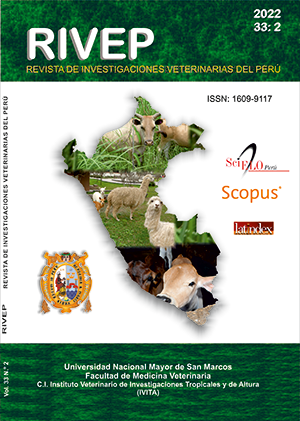Characterization of the guinea pig production system of the Mocha canton, Ecuador
DOI:
https://doi.org/10.15381/rivep.v33i2.22576Keywords:
Cavia porcellus, rural economy, production system, indigenous guinea pig, commercial linesAbstract
The aim of this study was to characterize the guinea pig production system in the Mocha canton, Ecuador. All 124 producers in the canton were surveyed. A population of 14 165 ± 130 guinea pigs was found, of which 85.5% are commercial lines and 14.5% are native. The most widely used breeding system was the Family-Commercial (up to 100 guinea pigs) with 50.8% of the producers, followed by the Commercial system (more tan 100 guinea pigs) with 37.9%, and the Family system (up to 25 guinea pigs) with 11.3%. Breeding is done mostly by women (76.6%). The survey showed that 83.1% of the producers have received training courses on raising guinea pigs. The facilities in ponds are the most used (54.8%), followed by cages (31.5%) and mixed (13.7%). The facilities are cleaned monthly (67.8%), biweekly (28.2%) or weekly (4.0%). Guinea pigs are mostly marketed biweekly (66.1%) in the local market. The most frequent pathologies are salmonellosis (63.7%) and lice (83.1%).
Downloads
Downloads
Published
Issue
Section
License
Copyright (c) 2022 Ismael Chavez-Tapia, Diana Avilés-Esquivel

This work is licensed under a Creative Commons Attribution 4.0 International License.
AUTHORS RETAIN THEIR RIGHTS:
a. Authors retain their trade mark rights and patent, and also on any process or procedure described in the article.
b. Authors retain their right to share, copy, distribute, perform and publicly communicate their article (eg, to place their article in an institutional repository or publish it in a book), with an acknowledgment of its initial publication in the Revista de Investigaciones Veterinarias del Perú (RIVEP).
c. Authors retain theirs right to make a subsequent publication of their work, to use the article or any part thereof (eg a compilation of his papers, lecture notes, thesis, or a book), always indicating the source of publication (the originator of the work, journal, volume, number and date).










